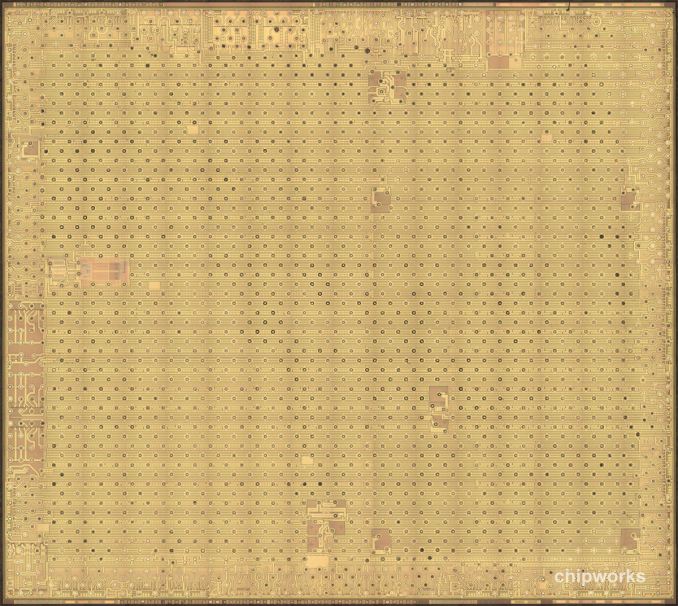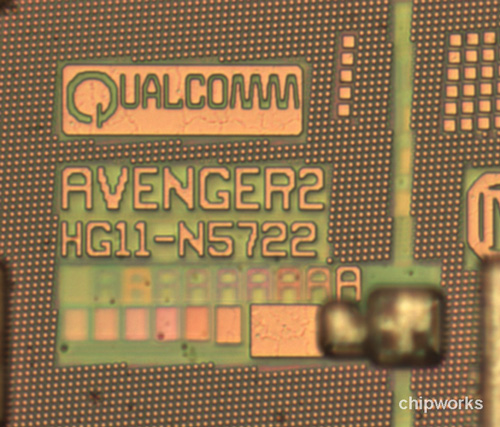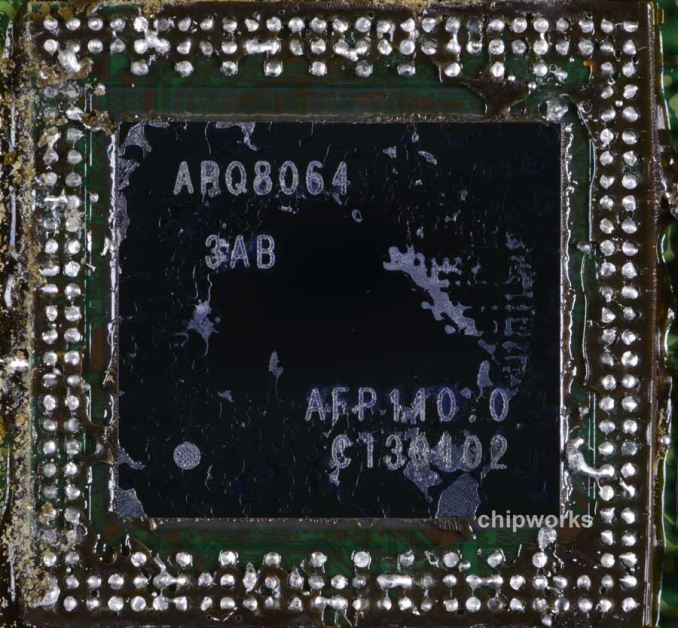Samsung Galaxy S 4 Review - Part 1
by Brian Klug on April 24, 2013 12:01 AM ESTGalaxy S 4 - Powered by a Better Snapdragon 600 (APQ8064AB)?
At a high level, Samsung's Galaxy S 4 integrates Qualcomm's Snapdragon 600 SoC. From what Qualcomm told us about Snapdragon 600, we're dealing with four Krait 300 cores and an Adreno 320 GPU. The Krait 300 cores themselves are supposed to improve performance per clock over the original Krait CPU (Krait 200) through a handful of low level microarchitectural tweaks that we've gone through here. The Krait 300 design also allegedly improves the ability to run at higher frequencies without resorting to higher voltages. This isn't the first time we've talked about Snapdragon 600, but since then a few things have come to light.

Snapdragon 600 from HTC One - Chipworks
For starters, Chipworks got their hands on a Snapdragon 600 SoC (from an HTC One) and delayered the SoC. In its investigation, Chipworks discovered that Snapdragon 600 had the exact same die area as the previous generation Snapdragon S4 Pro (APQ8064). Also, although you'd expect APQ8064T markings on the chip itself, the part carried the same APQ8064 label as previous S4 Pro designs.

Avenger 2 Markings on Snapdragon 600 die from HTC One - Chipworks
Chipworks did note however that there were some subtle differences between a standard APQ8064 and the Snapdragon 600 SoC from the HTC One. The Snapdragon 600 from the One is labeled with an Avenger2 codename rather than Avenger, the latter was apparently present on prior APQ8064 designs. Chipworks also noticed differences in the topmost metal layer, although it's not clear whether or not they stopped there or found no differences in lower layers.
All of this points to a much more subtle set of physical differences between APQ8064 and the earliest Snapdragon 600s. Metal layer changes are often used to fix bugs in silicon without requiring a complete respin which can be costly and create additional delays. It's entirely possible that Krait 300 was actually just a bug fixed Krait 200, which would explain the identical die size and slight differences elsewhere.
That brings us to the Galaxy S 4. It's immediately apparent that something is different here because Samsung is shipping the Snapdragon 600 at a higher frequency than any other OEM. The Krait 300 cores in SGS4 can run at up to 1.9GHz vs. 1.7GHz for everyone else. Curiously enough, 1.9GHz is the max frequency that Qualcomm mentioned when it first announced Snapdragon 600.
Samsung is obviously a very large customer, so at first glance we assumed it could simply demand a better bin of Snapdragon 600 than its lower volume competitors. Looking a bit deeper however, we see that the Galaxy S 4 uses something different entirely.
APQ8064 from a Snapdragon 600 based HTC One - Chipworks
Digging through the Galaxy S 4 kernel source we see references to an APQ8064AB part. As a recap, APQ8064 was the first quad-core Krait 200 SoC with no integrated modem, more commonly referred to as Snapdragon S4 Pro. APQ8064T was supposed to be its higher clocked/Krait 300 based successor that ended up with the marketing name Snapdragon 600. APQ8064AB however is, at this point, unique to the Galaxy S 4 but still carries the Snapdragon 600 marketing name.
If we had to guess, we might be looking at an actual respin of the APQ8064 silicon in APQ8064AB. Assuming Qualcomm isn't playing any funny games here, APQ8064AB may simply be a respin capable of hitting higher frequencies. We'll have to keep a close eye on this going forward, but it's clear to me that the Galaxy S 4 is shipping with something different than everyone else who has a Snapdragon 600 at this point.











335 Comments
View All Comments
Reikon - Wednesday, April 24, 2013 - link
Um, you said the SGS4 beats the other phones on accuracy. I'm pointing out that you're wrong. And now when I do, you claim accuracy isn't important.And I have no idea what you mean by "dynamics." Do you mean contrast? It's shown on the charts even though he didn't separate them out. And preference between higher contrast and accuracy is a subjective one. You can't say which one people prefer more. Many people prefer accuracy more than "feeling."
krumme - Thursday, April 25, 2013 - link
You might want to look at the color charts again. The S4 beats the One on color accuracy.And yes the dynamics of the picture is the contrast for black white, and each of the individual colors. The S4 is what 100 times better?- ofcourse that does not directly translate into perception, but everyone can see the difference. Everyone prefers the livelyness of the picture here.
You better get used to it. Every high-end phone will have amoled in 2 years. The reason only Samsung have it now, is because they are the only one who masters it on this production scale.
sigmatau - Thursday, April 25, 2013 - link
Good luck with the S4 in sunlight unless you don't crawl outside at all.krumme - Thursday, April 25, 2013 - link
Yeaahttp://www.gsmarena.com/samsung_galaxy_s4-review-9...
UpSpin - Thursday, April 25, 2013 - link
That review is pretty inconsistent:'The brightness levels of the Samsung Galaxy S4 are about on par with the rest of the company's AMOLEDs, which is to say not very high. However, due to their low reflectivity, this doesn't affect outdoor performance'
But a a few lines below they suddenly write:
'The Galaxy S4 is a solid performer outdoors, although surprisingly not any better than the Galaxy S III, despite its slightly higher brightness. Perahps, the new Gorilla Glass causes a dash of extra reflections and offsets the advantage.'
So it's as bad as the Galaxy S3. First they say it shouldn't be reflective, but then they say it's even more reflective than the S3, which already has a poor outdoor performance, just google for something like 'galaxy s3 outdoor visibility' and you'll see that people aren't happy with it outdoors.
Your mentioned review also says:
'Its impressive contrast and almost perfect viewing angles make everything on the screen pop, regardless of your viewpoint. '
Which is exactly the opposite to:
http://www.phonearena.com/reviews/Screen-Compariso...
'Then come the AMOLED displays of the Galaxy S4 and Galaxy S III, which are quick to become bluish even when looked at a slight angle. Otherwise, they do well retaining relative contrast and brightness. However, the quality LCD screens of the iPhone 5 and One do equally well, and even manage to retain a more natural color balance'
Phonearena however does not only write some false stuff, but also proof their statements with pictures.
Regarding outdoor usability they say:
'This lack of brightness also leads to worse visibility in outdoor conditions for the AMOLED screens. The Galaxy S4 isn't unusable, but it's perceptibly harder to read than the bright screens of the Apple iPhone 5 and HTC One, which lead the pack in this respect.'
krumme - Thursday, April 25, 2013 - link
Spin it what ever you want, but gsmarenas measurements, not personal assessments, show the S4 to have a sunlight contrast ratio of 3353 vs. 2500 for the One. No other way to put it.I dont know about phonearena. Their review is 4 small pages, with no measurements only blog talk. They give S4 a higher rating than One, but i would not put to much credibility in this blog.
And you say Phonearena had pictures? Yeaa i know i look at them with both new oled, ips and pls screen. Have you read their camera comparison?
http://www.phonearena.com/reviews/Camera-compariso...
sigmatau - Thursday, April 25, 2013 - link
My personal assessment shows that you can't read shit on a Samsung OLED screen outside. Even Anand said that the HTC One's screen kills the S3's. We are talking about the screen, btw, not the camera. Nice try of a deflection.krumme - Friday, April 26, 2013 - link
If you leave the S4 in automatic brightness mode, the screen can go as much as 34% brighter compared to the maximum of manual mode. That’s 68% brighter than the maximum of the Galaxy S IIIhttp://www.displaymate.com/Galaxy_S4_ShootOut_1.ht...
There is a difference to Oled screens you know.
hyperdoggy - Wednesday, April 24, 2013 - link
yes, yes...and yes?krumme - Wednesday, April 24, 2013 - link
remember to charge between each "yes"